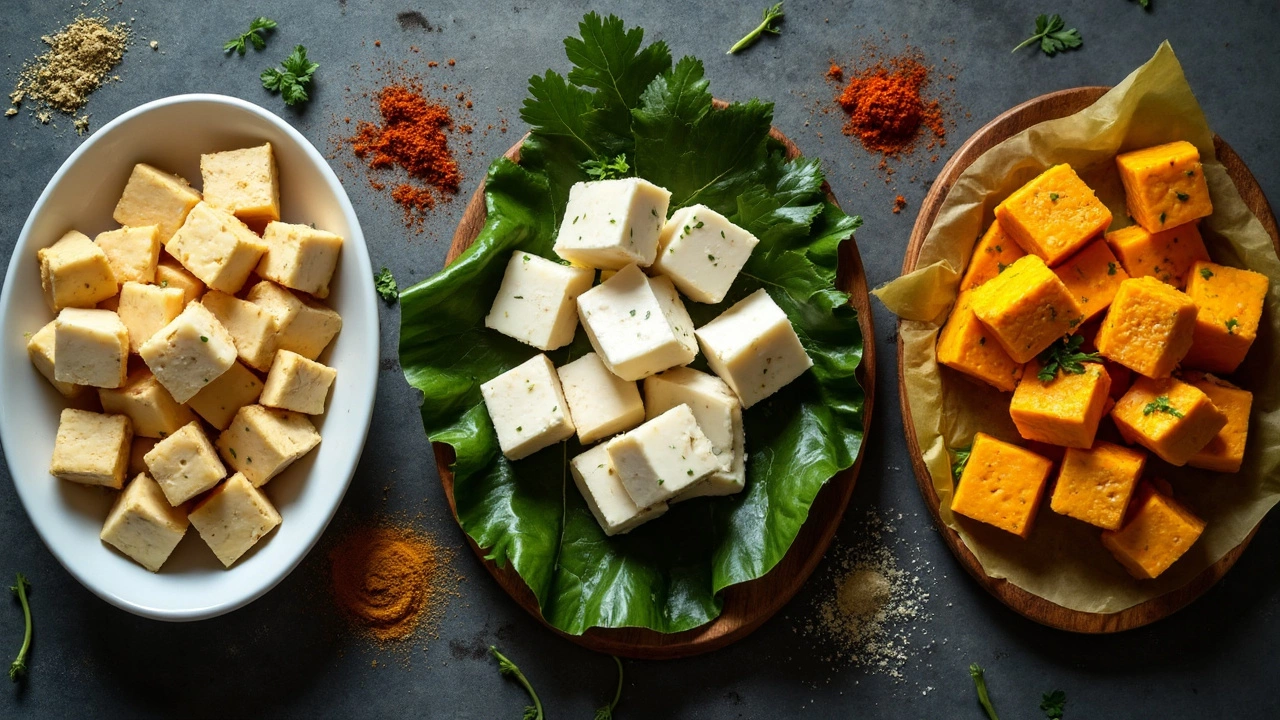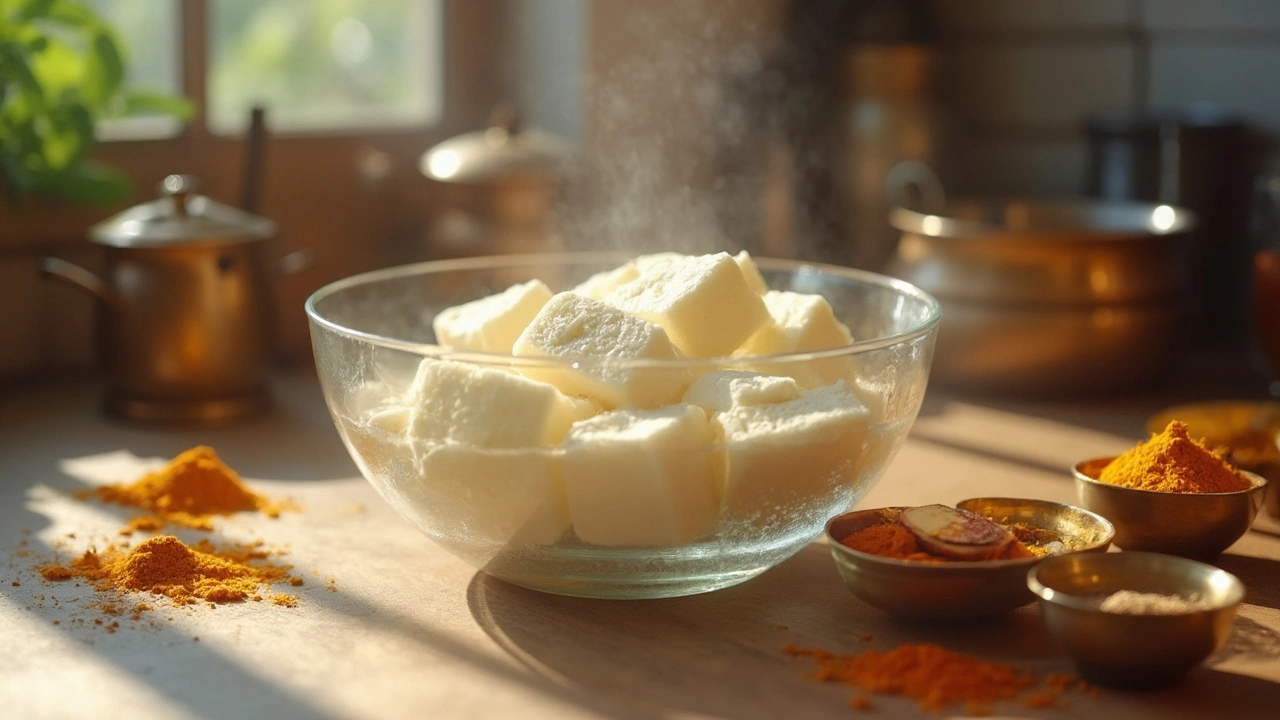If you’ve ever bitten into paneer and found it chewy like a rubber band, you’re not alone. Most people grab it straight from the fridge or cut cubes from a fresh homemade slab and toss them right into the pan. Thing is, without soaking, paneer just can't do its magic. Soaking is the easiest fix, and it only takes a few minutes.
Here’s the deal: as soon as paneer cools down after making, or sits refrigerated, it firms up and gets dense. That’s great for holding shape, but not for mouthfeel. When you soak those cubes in warm water, you’re letting them drink up just enough moisture to soften and turn pillowy. Your curries start to taste like they do at that one restaurant you love – tender, juicy, and never squeaky between your teeth.
No fancy equipment needed – just a bowl and some water. This single step can save you from dry or flavorless paneer, and no one will ever call your palak paneer 'hard' again. Curious why this works? It comes down to the way milk proteins tighten up, but trust me, your taste buds will notice the difference before your brain does.
- Why Paneer Gets Hard Without Soaking
- The Best Way to Soak Paneer
- How Soaking Affects Taste and Texture
- Common Mistakes to Avoid
- Expert Tips for Perfect Paneer Every Time
Why Paneer Gets Hard Without Soaking
Ever wondered why paneer sometimes gets tough and rubbery? It’s actually not because you did something terribly wrong in the kitchen. It’s just how paneer works. When you make fresh homemade paneer, you use acid (like lemon juice or vinegar) to split the milk into curds, then press those curds together to get that firm block we all know and love. But after pressing, the proteins in milk squeeze tight together and lock in, making the paneer dense. As it cools or especially if it’s stored in the fridge, it loses more moisture, so it only gets firmer over time.
If you slice straight from the fridge, you’ll notice that store-bought paneer is even denser because it’s already designed to hold its shape during travel and shelf-life. This makes it even less forgiving if you skip the soaking step. Here’s what actually happens inside:
- The protein chains in paneer contract when they cool or sit in cold storage.
- This makes water escape, leaving the paneer dry on the inside.
- With less water, the texture goes from soft and crumbly to firm and chewy.
Just to get an idea, a fresher block of paneer can have up to 50% moisture content when just made. Check out this quick comparison:
| Paneer Type | Moisture Content |
|---|---|
| Fresh Homemade | Up to 50% |
| Store-Bought (from fridge) | About 40% or less |
When you cook unsoaked paneer, the dryness means it doesn’t soak in gravies or spices well—it just sits there like a bland, chewy cube. That’s when you end up wishing for the soft, restaurant-style result. So soaking is less about fixing mistakes and more about undoing what cold storage and time do to an otherwise great cheese.
The Best Way to Soak Paneer
The trick to good soak paneer isn’t complicated, but a lot of people get it wrong by using cold water or by soaking it too long. Only warm water does the job right. If you’re making homemade paneer, wait until it cools and firms up in the fridge, then soak right before you cook.
Here’s how to do it step-by-step:
- Cut your paneer into even cubes for even soaking. Thick cubes (about 1 to 1.5 cm) work best; thin slices might fall apart.
- Heat some water until it’s hot but not boiling – you want it around 50-60°C (just a little hotter than a nice bath). If you can dip a finger in quickly without burning, it’s just right.
- Place the cubes in a bowl and pour the hot water over them until the paneer is fully covered.
- Let the paneer sit for 10-15 minutes. No more than 20 minutes, or it’ll start getting too soft and crumbly, especially if it’s fresh.
- Drain off the water and pat the paneer dry with a clean towel or kitchen paper before cooking.
If you’re dealing with store-bought paneer, soaking makes an even bigger difference. Most brands sell paneer that’s extra-firm for shipping, so this softens it up and pulls it back to that homemade, juicy texture.
Want to see how different methods compare? Here’s a quick table:
| Soaking Method | Result |
|---|---|
| Cold Water, 20 min | Doesn’t soften much, still firm |
| Room Temp Water, 20 min | Somewhat soft, not ideal |
| Warm Water, 15 min | Pillowy, juicy, absorbs flavor well |
| No Soaking | Rubbery, sometimes squeaky |
If you want even more flavor, some people add a pinch of salt to the soaking water, which can help the paneer pick up seasoning. But keep it simple—plain water is enough for great results. Make sure to stick to the soaking times so your paneer doesn’t fall apart when cooked, especially in curry or stir-fries.

How Soaking Affects Taste and Texture
Soaking is what separates average homemade paneer from something you’d want second helpings of. When you dunk those cubes in warm water, it changes the game in two big ways: taste and texture.
First up, let’s talk texture. After paneer cools down or is stored in the fridge, the protein structure gets tighter. That’s why it starts to feel tough or rubbery, especially if you use store-bought paneer. A soak loosens up those proteins and brings back the softness you expect from good homemade paneer. You’ll get cubes that are springy but not spongy, and that gently bounce back when you press them with a spoon.
On the taste front, soaking lets your paneer actually pick up flavors. Try making matar paneer or paneer tikka with dry cubes—the flavors just slide off. When you soak, those little holes inside the paneer open up and act like tiny flavor pockets. So instead of just tasting curry on the surface, you’ll notice the spices going all the way through each piece.
Chef Ranveer Brar, pretty much the go-to for any Indian food dilemma, says:
“Warm water soaking is the secret behind that dhaba-style soft paneer everyone tries to copy at home. It’s not just about making it soft, it’s about helping it hold onto the flavors of the curry.”
If you really want proof, check out this simple comparison between soaked and unsoaked paneer after 10 minutes in gravy:
| Paneer Type | Texture | Flavour Absorption |
|---|---|---|
| Unsoaked | Rubbery, firm | Mainly on surface |
| Soaked (10 min) | Soft, slight bounce | Curry seeps deep |
Bottom line: if you skip soaking, you miss out on the melt-in-your-mouth experience—and you’ll wonder why your cooking still tastes a bit flat, even after all that effort. So if soft, flavorful paneer is the goal, soaking takes you there every single time.
Common Mistakes to Avoid
Messing up with soak paneer can mess up your recipe. Loads of people waste good paneer by making these simple mistakes. Let's break down what you should watch out for so your homemade paneer always turns out just right.
- Using Cold Water Instead of Warm: Warm water helps relax the paneer structure, making it soak up moisture quicker. Cold water won’t do the job fast enough and leaves the inside chalky. Stick to warm, not hot, or you could end up melting the paneer edges.
- Soaking Too Long or Too Short: Ten to fifteen minutes is sweet spot. Less than that and it’s still tough; go over thirty minutes, and the cubes start to weaken, losing their shape and falling apart in your curry.
- Skipping Soaking for Store-Bought Paneer: Packaged paneer gets even denser in the fridge. If you skip the soak, it’ll stay bouncy and weirdly rubbery—nothing like what you’d get in a good restaurant with soft, spongy cubes.
- Slicing Paneer Before Soaking: Always cut the blocks into cubes before soaking. If you try to soak a big chunk, the inside doesn’t get enough water and stays dry, while the outside turns mushy. Uniform soaking is key.
- Not Draining Properly: Nobody loves curry that’s watered down. After soaking, let paneer sit for a couple of minutes on a clean kitchen towel or in a sieve so you don’t drag extra water into your dish.
Here's a snap look at what could go wrong if you ignore these tips:
| Mistake | Result |
|---|---|
| Cold water soak | Chalky, tough texture |
| Soak too long | Paneer falls apart |
| No soak (store-bought) | Rubbery, bouncy cubes |
| Soak whole block | Dry middle, mushy outside |
| No draining | Watery curry |
You don’t need to be a chef to get paneer right every time. Just dodge these common mistakes and your Indian cooking will taste a lot more authentic—promise.

Expert Tips for Perfect Paneer Every Time
Let’s get practical about nailing homemade paneer that’s soft, tasty, and never bland. Over the years, people have tried all sorts of tricks, but these are the ones that actually work. Save these steps the next time you handle paneer and you’ll never get complaints.
- Always soak paneer right before cooking, even if just for 10 minutes. If it’s straight from the fridge, use warm (but not hot) water. For fresh homemade paneer, 5 minutes is enough. This helps bring back that soft, milky texture.
- Don’t salt the soaking water. Some recipes say to add salt, but it won’t really travel into the cubes and might just make the outside rubbery.
- Cut paneer cubes into even sizes so they soak evenly. Uniform pieces also cook more consistently, so you won’t get some hard and some mushy bits in one bite.
- If your paneer is really hard (think store-bought two-day-old stuff), microwave it for 20 seconds before soaking. This makes the soak much more effective.
- After soaking, dry the cubes gently with a paper towel before frying or adding to curries. Damp paneer can spatter in hot oil or break up in the sauce.
- Toast the cubes in a nonstick pan with a drop of ghee if you want extra flavor and sturdiness. Skip this if you like creamy, soft-inthe-curry paneer.
- Always add soaked paneer towards the end of cooking. Long simmering turns even the softest cubes tough and chewy.
If you’re a fan of data, here’s what a simple test showed when soaking different kinds of paneer:
| Paneer Type | Soaked (10 mins) | Not Soaked |
|---|---|---|
| Homemade Fresh | Soft, creamy | A little firm |
| Store-bought Fresh | Much softer, absorbs gravy | Rubbery, dry inside |
| Store-bought Old | Edible, semi-soft | Hard, chewy |
One last tip—don’t freeze and thaw paneer over and over. It wrecks the texture for good, and no soak will save it after that. Keep your soak paneer strategy simple and these tips in your back pocket, and your paneer will always be the highlight of the plate.
